If you’re looking for the most authentic Japanese experiences in Tokyo, I’ve done all the time-consuming groundwork for you to curate the very best you can actually book right away, so you can skip the research and focus on what matters: choosing the ones that speak to you most.
Summary
Avoid the tourist crowds and gain exclusive access to Tokyo’s living traditions – from morning sumo training to Michelin-trained sushi masters – with five bookable cultural experiences that offer genuine interaction with master artisans.
Key Takeaways
- Limited availability – these intimate experiences accommodate small groups only and require advance booking (1-11 days depending on activity)
- Witness active sumo wrestlers – training at dawn in authentic Tokyo stables with your own private guide (from ¥26,000)
- Craft heirloom chopsticks – using 110-year-old Edo woodworking techniques with third-generation master Yutaka Mogami
- Step behind the sushi counter – for exclusive instruction from Chef Kenichiro Hirai, trained at a Michelin-starred restaurant (private venue, 1-8 guests)
- Practice zazen meditation – at a 400-year-old Zen temple founded by Tokugawa Ieyasu’s daughter, guided by the head priest
- Learn kintsugi repair – techniques on premium Japanese ceramics in historic Nihonbashi, transforming broken pottery into golden-seamed art
Listen to the podcast ►
Want More Free Content Like This?
- Summary
- Key Takeaways
- Authentic Japanese experiences in Tokyo
- 1. Witness Morning Sumo Training at a Private Tokyo Stable
- 2. Craft Your Own Chopsticks with a Third-Generation Edo Woodworking Master
- 3. Make Sushi Behind the Counter with a Michelin-Trained Master Chef
- VIDEO: The Way of a Sushi Chef in Tokyo – Masters of Japan
- 4. Practice Zazen Meditation at a Historic Asakusa Zen Temple
- 5. Repair Fine Ceramics with Modern Kintsugi Techniques in Nihonbashi
- Planning your Tokyo cultural experiences
- Recommended for you
- RESOURCES
- Leave A Comment / Ask A Question
- About the Author
Authentic Japanese experiences in Tokyo
Authentic Japanese experiences in Tokyo go far beyond the over-saturated tourist spots. The city’s most memorable encounters happen in working studios, training grounds, and intimate spaces where master artisans still practice centuries-old traditions.
These aren’t museum exhibits or performances staged for tourists. These are working studios, active training grounds, and intimate spaces where Japan’s living traditions continue to evolve. The challenge? Most require advance booking, operate with limited capacity, and remain largely unknown to most international travellers.
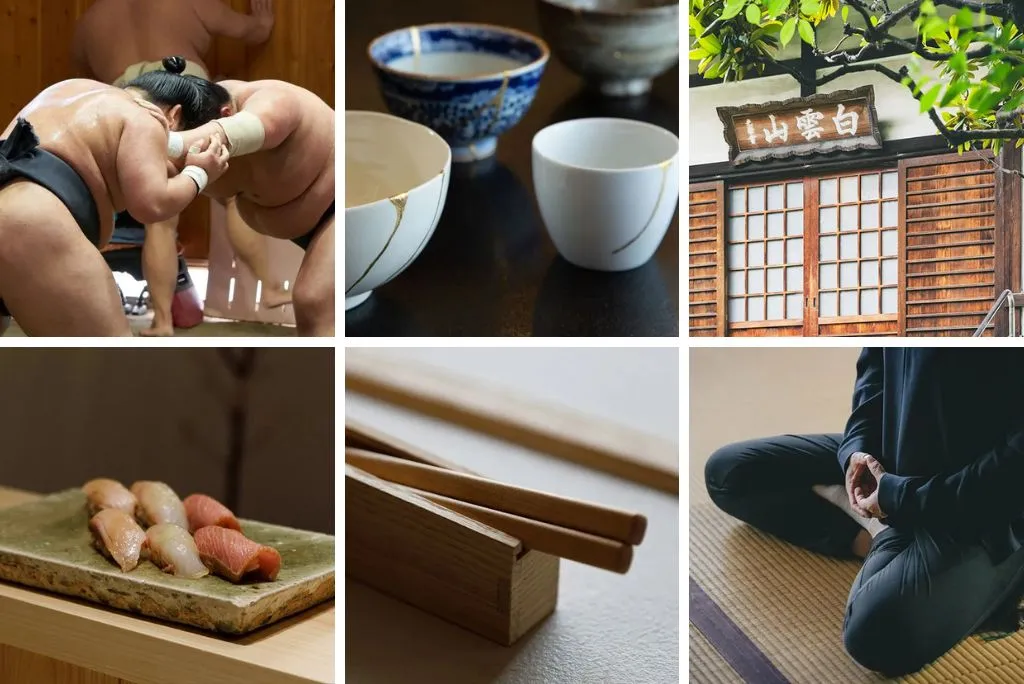
That’s where this guide comes in. I’ve curated five exceptional cultural experiences in Tokyo that you can book right now.
Each offers genuine interaction with master practitioners, hands-on participation in centuries-old crafts, and the kind of insider access that transforms a trip into a true immersion. Whether you’re planning your activities for next month or next week, these experiences have availability – but they won’t stay that way for long.
1. Witness Morning Sumo Training at a Private Tokyo Stable
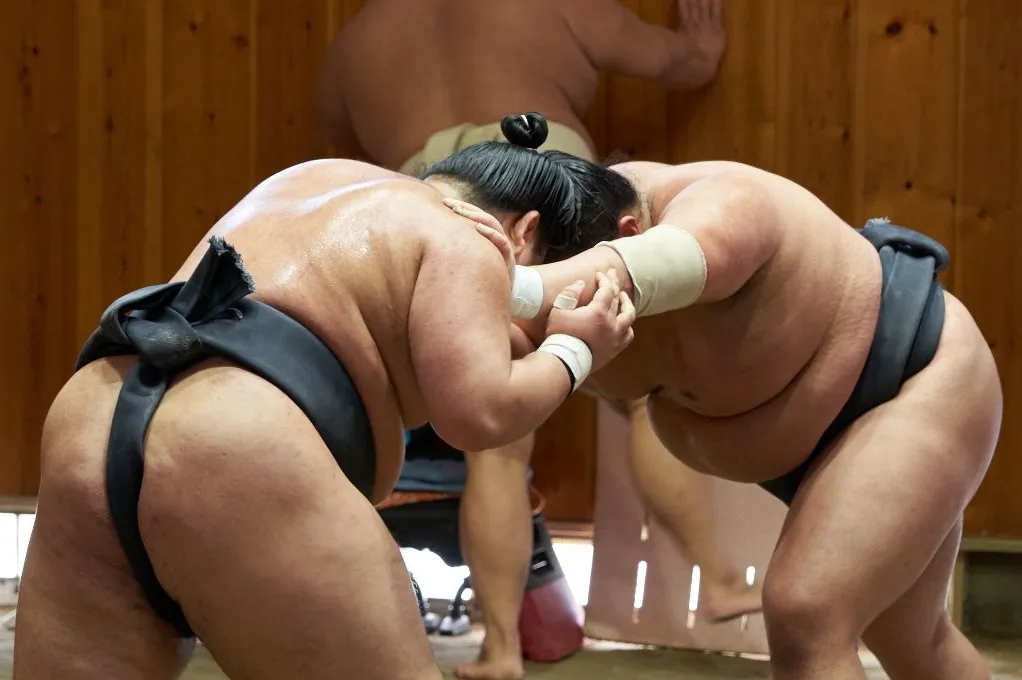
The pre-dawn streets of Tokyo’s Sumida Ward hold one of Japan’s most exclusive cultural encounters. While most travellers photograph the famous Ryogoku Kokugikan stadium from the outside, you’ll step into an active sumo stable to witness rikishi (sumo wrestlers) in their daily morning practice – a privilege typically reserved for stable members and special guests.
What makes this sumo experience authentic
Sumo’s traditions stretch back to the 8th century, documented in Japan’s oldest chronicles. The morning training session, or keiko, follows protocols established during the Edo period when sumo evolved into its current form. This isn’t a demonstration for tourists – it’s the actual training that prepares wrestlers for professional tournaments.
Your private escort guide meets you before entering the stable to explain what you’ll witness and the etiquette required. The stable itself is sacred space. The dohyo (training ring) represents hallowed ground, and silence during practice is absolute. You’ll hear every collision of bodies, every scraping foot, even the controlled breathing of wrestlers engaged in centuries-old conditioning exercises.
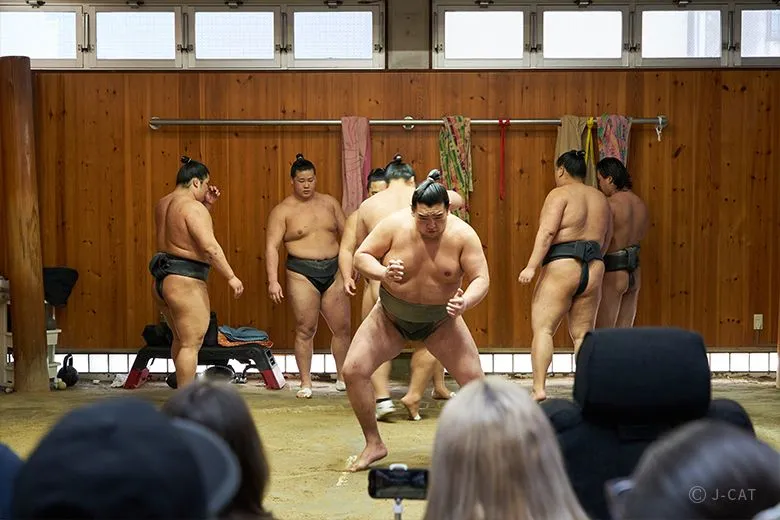
The atmosphere is electric! Rikishi practice suriashi – the distinctive sliding footwork that strengthens their lower bodies. Junior wrestlers face senior champions in intense bouts that showcase the raw power and refined techniques that define sumo. Your observation area sits directly ringside, close enough to feel the impact when a 150-kilogram wrestler hits the clay floor.
The details that matter
Unlike large group tours with single guides, this experience provides your party with a dedicated escort who offers detailed context before and after the session. During the 45 to 120-minute training window (typically 7:30-10:30 AM), you’ll observe the complete practice ritual from warm-ups through final bouts.
After training concludes, wrestlers often become surprisingly warm and welcoming, happy to pose for photos and answer questions through your guide. The contrast between their fierce practice intensity and their gentle, jovial personalities outside the ring offers genuine insight into sumo culture that few visitors ever experience.

Why I think this experience is special
Unlike group tours where you often strain to hear a single guide, you’ll have your own private escort providing detailed context before and after – plus the rare chance to chat and photograph with the wrestlers after they’ve finished their intense practice.
Practical booking notes: The specific stable location is confirmed 3-7 days before your visit. Winter mornings are notably cold in these unheated practice spaces – so I recommend dressing warmly. Masks are required for entry, and late arrivals cannot be accommodated. Women should wear trousers or skirts covering the knees, and everyone removes their shoes (socks required).
Book Your Sumo Morning Practice Experience →
2. Craft Your Own Chopsticks with a Third-Generation Edo Woodworking Master
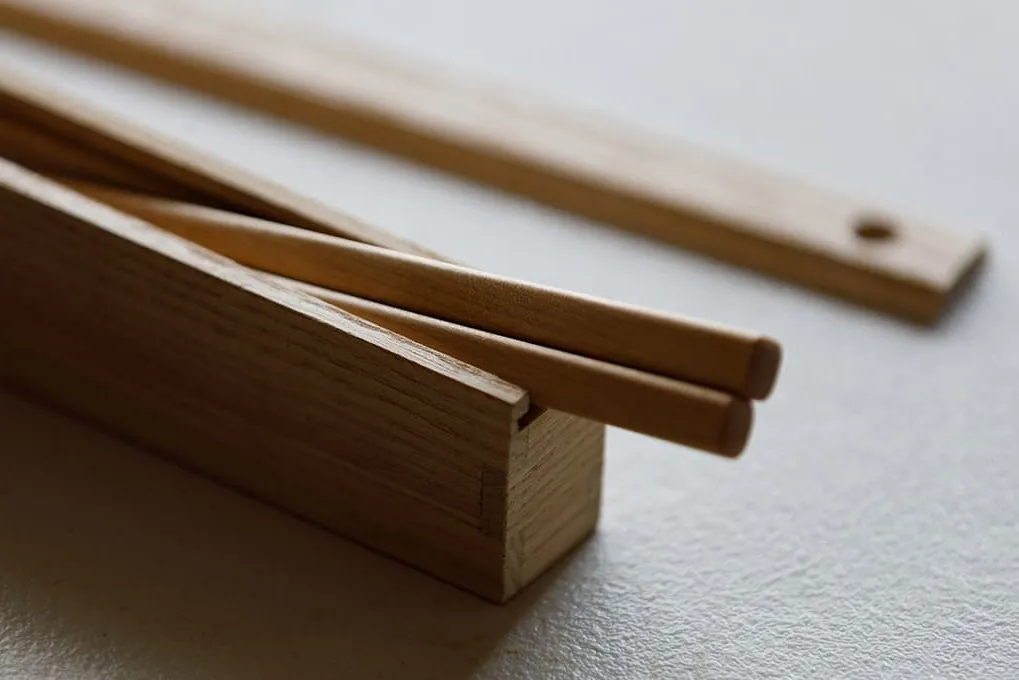
In Tokyo’s Kuramae district, where traditional artisans work alongside contemporary creators, Mogami Kogei has practiced Edo sashimono woodworking for 110 years. Here, third-generation master Yutaka Mogami – or his son and successor Ryo – will guide you through creating a pair of custom chopsticks using techniques that have barely changed since the Edo period.
The art of Edo sashimono
Sashimono means “to join wood” or “to make using a ruler,” and during the Edo period, this joinery style created furnishings for samurai and merchant classes. The craft’s defining characteristic is its minimalist elegance – mortise-and-tenon joints so precise they appear delicate yet prove remarkably sturdy. Traditional kabuki dressing room furniture still uses this same technique today.

Mogami Kogei is one of only about ten remaining Edo sashimono workshops in Tokyo. Walking into Yutaka’s studio means entering a space saturated with wood aroma and oil polish, where over one hundred hand planes line the walls alongside saws, chisels, and tools most modern craftspeople have never seen.
Your hands-on chopsticks making experience
Every sashimono apprentice begins by learning to make chopsticks – and so will you. Your first decision is wood selection. Handle samples of maple, ash, oak, hiba cypress, and hinoki cypress. Feel their weight, smell their distinct scents, examine their grain patterns. Hardwoods from broad-leaf trees offer tight, dense grains. Softwoods from conifers provide aromatic, lighter alternatives.
As you work, the wood transforms under sandpaper and perilla oil finishing. Unlike assembly-line production, Edo sashimono requires solo artisans to complete every step personally. Your chopsticks will be genuinely yours – shaped by your hands, finished by your effort.
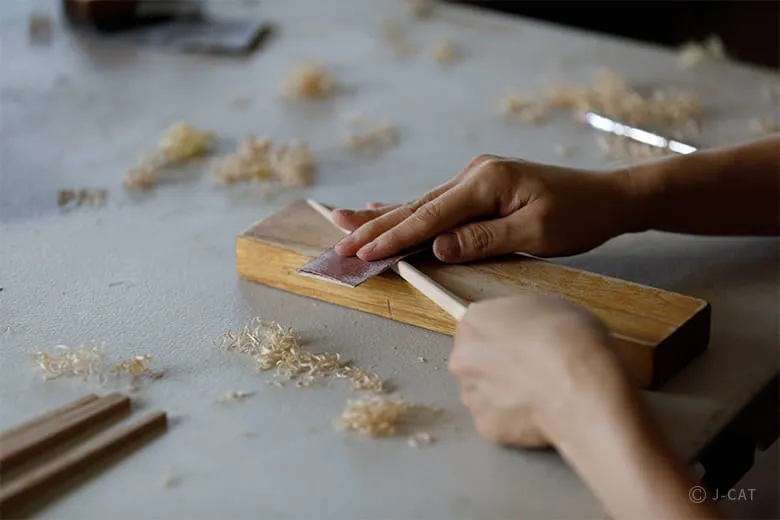
What you’ll take home
Your completed chopsticks come housed in an artisan-made box of premium Aizu paulownia wood – the same quality container used for heirloom pieces. For an additional fee (book 10 days ahead), you can add traditional Edo-style lettering engraving to your box, featuring the bold, auspicious characters that have symbolised good fortune since the 1600s.
Quality Edo sashimono chopsticks last decades with minimal care. After years of use, a simple surface scraping and fresh oil application can make them family heirlooms for the next century.
Why I think this chopstick making experience is special
You’re learning from one of only ten remaining Edo sashimono workshops in Tokyo, working with the same hand tools and techniques that have crafted everything from samurai furniture to kabuki dressing room pieces for over 400 years.
Book Your Chopstick Making Experience →
3. Make Sushi Behind the Counter with a Michelin-Trained Master Chef

The district of Nishi-Azabu in Tokyo hosts some of Japan’s finest sushi restaurants packed shoulder-to-shoulder, each competing for distinction. In 2022, Chef Kenichiro Hirai opened Sushi Hazan here after honing his craft at Udatsu Sushi, recognised with a Michelin star. His eight-seat restaurant with its single hinoki counter exemplifies the poise required in Tokyo’s most demanding culinary arena.
Now Chef Hirai (featured in the video below) offers something extraordinary: the chance to step behind that counter yourself, learning traditional Edomae sushi techniques under his direct guidance while the entire restaurant remains exclusively yours.
VIDEO: The Way of a Sushi Chef in Tokyo – Masters of Japan
Understanding Edomae tradition
Edomae-style sushi represents Tokyo’s (formerly Edo’s) traditional approach, emphasising technique to enhance each fish’s inherent flavour. Cold-aged maguro tuna, hirame flounder dried and salted before resting in kelp wraps, vinegared konoshiro shad – every preparation showcases masterful handling that spotlights ingredient quality.
Each nigiri sushi comprises two elements: shari (the pressed nugget of vinegared rice) and neta (the fish or main ingredient). The word neta literally translates as “subject,” “substance,” or “story” – a revealing insight into how sushi chefs view their craft.
Your time behind the counter
The tsukeba – a sushi restaurant’s kitchen workstation – traditionally remains sacred space accessible only to chefs. Chef Hirai welcomes you into this sanctuary specifically to demystify the craft. You’ll learn nigiri technique directly: dampening hands with vinegar, forming shari, spreading wasabi with precision, assembling pieces that look deceptively simple.
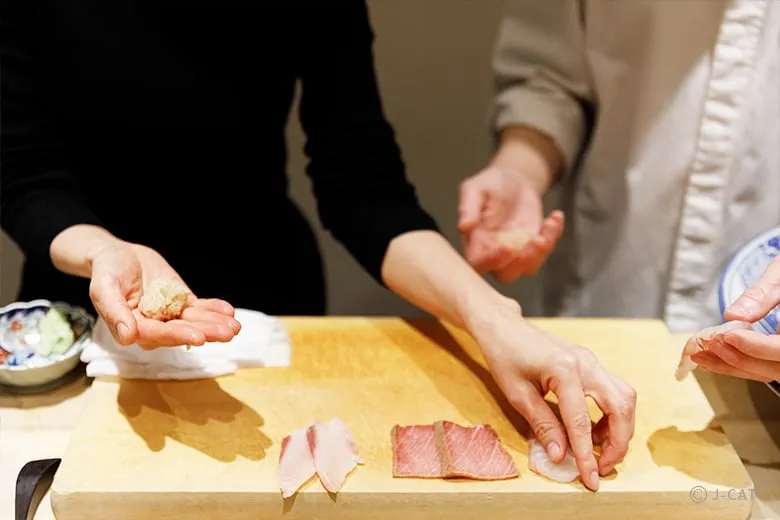
Then comes the revelation! You’ll taste sushi you’ve made yourself alongside pieces Chef Hirai crafted from identical ingredients. The difference is unmistakable and often shocking – he creates the perfect melt-in-your-mouth texture where rice and fish dance together, melding into harmonious bites that demonstrate why technique matters so profoundly.
The experience includes up to ten pieces of sushi. Choose to make all pieces yourself or split them to compare your work against the master’s. Most guests find the comparison approach the most rewarding.

The surprising challenge of wasabi
You’ll practice grating authentic Izu Peninsula wasabi on traditional sharkskin graters – a skill that proves surprisingly elusive. Most people resort to excessive force, which strips wasabi’s subtle flavour dimensions and leaves only harsh spice. Chef Hirai’s masterfully grated wasabi offers less overwhelming heat with more fragrance and depth, providing the perfect pairing for premium sushi.
Why I think this sushi making experience is special
This is your only chance to stand in the sacred tsukeba workspace behind the counter, typically forbidden to anyone but chefs, and directly compare your sushi against a Michelin-trained master’s using identical ingredients. How well will you do?!
Book Your Private Sushi Making Experience →
4. Practice Zazen Meditation at a Historic Asakusa Zen Temple
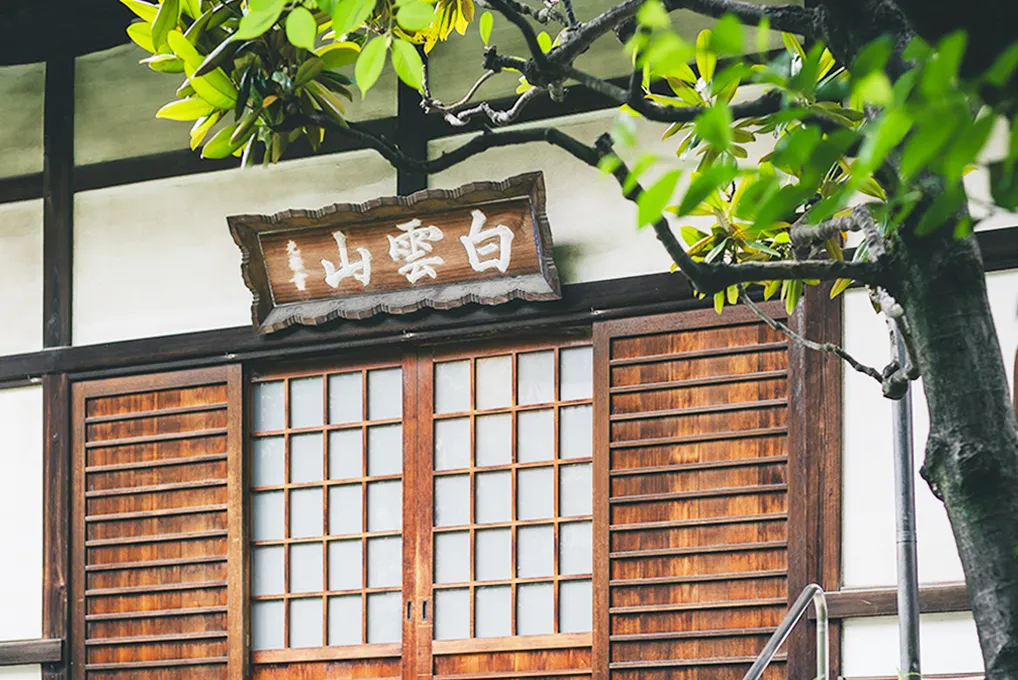
Step off Asakusa’s busy main road into Kinryuji temple, and the city’s energy dissolves into green-surrounded tranquility. Founded in 1611 by Kamehime – eldest daughter of Tokugawa Ieyasu, founder of Japan’s last shogunate – this Rinzai Zen temple offers rare private access to authentic zazen (meditation) practice under the guidance of the 23rd head priest.
A temple linked to the Tokugawa legacy
Kinryuji’s 400-year history connects directly to Japan’s most influential military dynasty. Originally built in Hatchobori, the temple relocated to its current Asakusa location in 1635. Though destroyed by the 1923 Great Kanto Earthquake and World War II air raids, the rebuilt structure maintains its traditional wooden architecture and atmosphere of profound calm.
The main hall where you’ll practice zazen sits surrounded by trees that shift with seasons – spring cherry blossoms and camellias, autumn’s vibrant leaves. The sturdy structure naturally quiets the mind, creating ideal conditions for meditation practice.
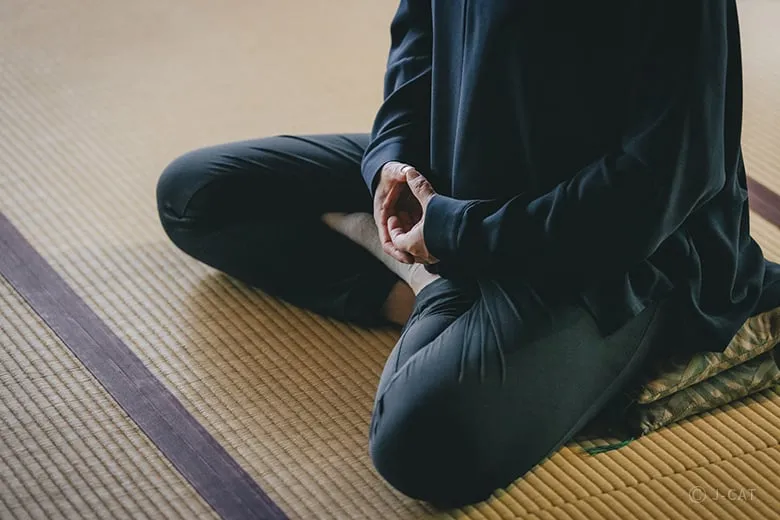
Your introduction to Zen meditation practice
Head priest Taijun Namiki, who also serves as director of the Tokyo Zen Center of the Myoshinji school, guides your experience personally. He begins by explaining Zen’s origins – how the Buddha attained enlightenment while sitting in zazen beneath the Bodhi tree – before covering practical methods including proper sitting posture and breathing techniques.
The priest chants the Enmei Jikku Kannon Sutra before Kinryuji’s main deity, the eleven-faced Kannon (Goddess of Mercy). The sutra’s echoes in the quiet hall create an atmosphere of profound stillness that prepares you for meditation.
The practice itself
Your zazen practice consists of three ten-minute sessions, each timed by burning incense sticks, with two-minute breaks between. Clappers and bells signal each session’s start and end. Though traditional zazen extends much longer, this format accommodates beginners while maintaining authentic practice.
Sit upright and focus on slow, deep abdominal breathing. The head priest guides you in susokukan – the Zen breathing technique where you count inhales and exhales to harmonise mind and body. Concentration proves difficult initially, but the structured counting helps focus wandering thoughts.
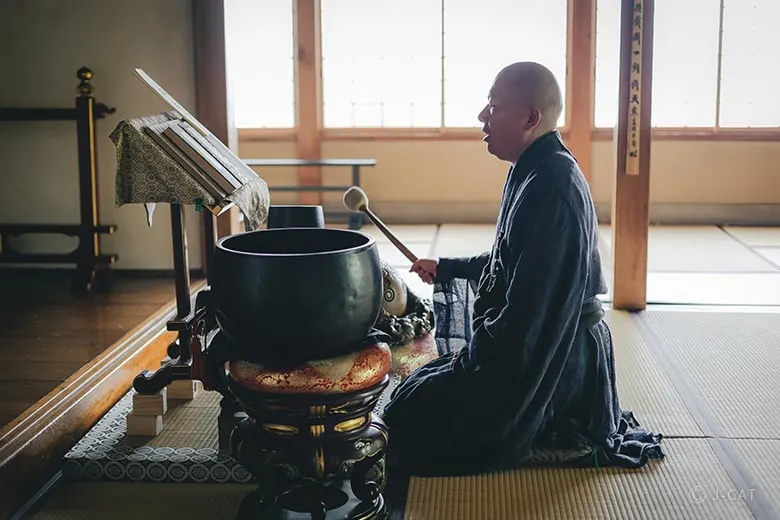
During practice, the head priest carries a keisaku – the flat wooden stick used to encourage proper posture with a sharp tap to the shoulders. You can request this traditional encouragement, which many find helps realign both physical posture and mental focus.
Tea and conversation with the head priest
Following zazen, the head priest prepares matcha tea, serving it alongside seasonal sweets from Ryushotei Nishimura, a 19th-century shop near Kaminarimon that supplies Sensoji Temple. This hospitality moment offers relaxed conversation about Zen practice and philosophy.
This combination of sutra recitation, zazen practice, tea ceremony, and personal instruction from a head priest creates rare opportunity to experience Zen’s profound depths in authentic temple setting just steps from Asakusa’s bustling streets.
Why I think this Zen meditation experience is special
You’re not joining a public meditation class – you’re receiving private instruction from the 23rd head priest of a temple founded by the daughter of Tokugawa Ieyasu himself, followed by personal conversation over tea he prepares for you. That’s extremely rare.
Book Your Private Zen Meditation Experience →
5. Repair Fine Ceramics with Modern Kintsugi Techniques in Nihonbashi

In Tokyo’s historic Nihonbashi district, Utsuwa Nihonbashi Mutoh Main Store has dealt in fine lacquerware and ceramics since 1923. it’s here you’ll learn kintsugi – the traditional Japanese method of repairing broken ceramics with lacquer and precious metal powder – through a modernised technique that compresses the complete process into a single afternoon.
The philosophy behind kintsugi
Kintsugi literally means “golden joinery,” and the practice embodies a uniquely Japanese aesthetic principle: broken objects repaired with precious materials become more valuable, more beautiful, more meaningful than their original undamaged form. The gold-filled cracks become “scenery” – visible testament to the object’s history and the care taken to preserve it.
Rather than discarding broken items, kintsugi represents sustainability through thoughtful repair, transforming damage into enhancement while extending an object’s useful life by decades or centuries. (Confession: I have a habit of breaking crockery at home, so my wife uses kintsugi experts to fix my accidents!)
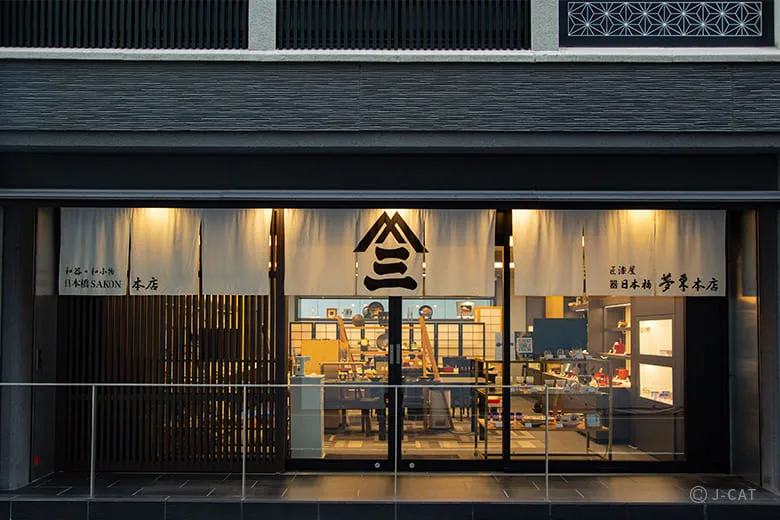
Your hands-on kintsugi experience
You’ll work with premium Japanese ceramics personally selected by Mutoh’s artisans for the day’s workshop. These represent some of Japan’s finest ceramic traditions, and you’ll repair one to take home.
The process begins with careful adhesive application using a toothpick to join cracked edges, pressing lightly to create invisible seams. Precision matters here – spreading adhesive thinly and evenly ensures perfect fit. Once dried, you’ll fill gaps with putty, working quickly before it hardens, pushing it into even the smallest chips and cracks with your fingers or a spatula.
After the putty hardens, you’ll file away any protruding parts to restore the ceramic’s original shape. Then comes the transformative moment: applying a mixture of lacquer and gold powder to the repair lines using traditional brushes. These gold-traced cracks become your ceramic’s new “scenery.”
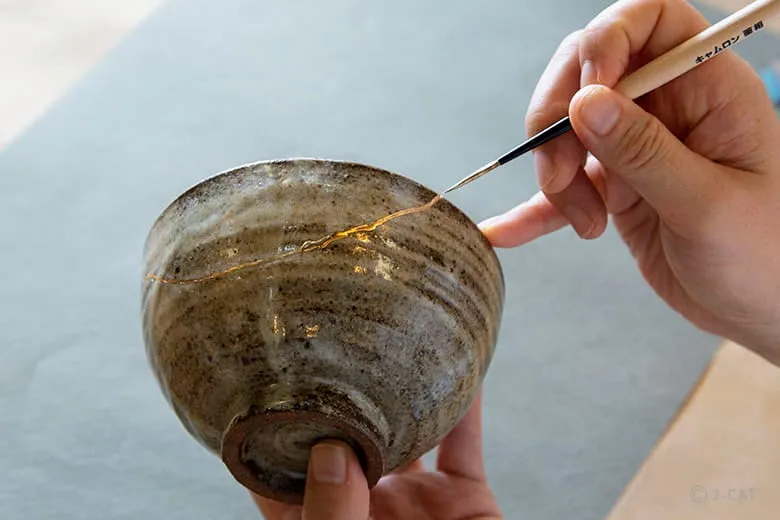
Don’t worry about perfect lines. Your instructor encourages relaxed focus rather than anxious precision. Slightly shaky lines and varying thickness add unique character to each piece, creating one-of-a-kind results that reflect your personal touch.
Optional traditional technique addition
For those seeking deeper engagement, an optional upgrade (additional fee) allows you to work with hon-urushi – genuine lacquer used by professional kintsugi artisans. This rare opportunity reveals traditional techniques that differ substantially from modern methods.
Traditional kintsugi uses entirely natural materials created from scratch. The adhesive combines lacquer with wheat flour. The gap-filling putty blends lacquer with wood flour, tonoko (powdered dried clay), and other natural ingredients. The foundation layer uses red lacquer (bengar-urushi) before final gold powder application.
Because genuine lacquer requires days to weeks to fully harden, your instructor completes preliminary steps in advance, allowing you to add finishing touches during your session – experiencing the authentic process while working within a single afternoon’s timeframe.
Understanding what you’ve created
During breaks as your work dries, your instructor explains kintsugi’s history, techniques, and the Japanese aesthetic principles it embodies. If desired, they’ll also guide you through Mutoh’s impressive selection of ceramics from across Japan, sharing insights into regional styles and production methods.
The ceramic you take home – whether Arita, Kyo Kiyomizu, or Kutani ware – represents high-quality craftsmanship suitable for daily use (though not for open flames, microwaves, or dishwashers). More importantly, it carries your own handiwork, transformed through an ancient practice that finds beauty in imperfection and value in thoughtful repair.
Why I think this experience is special: You’ll work with premium Arita, Kutani, or Kyo Kiyomizu ceramics (not practice pieces) and take home a genuinely valuable Japanese ceramic that you’ve personally transformed using gold and lacquer techniques.
Book Your Kintsugi Experience →
Planning your Tokyo cultural experiences
These five experiences represent Tokyo’s living traditions – not preserved museum pieces, but active practices continuing to evolve in the hands of master practitioners. Each offers genuine interaction with experts, hands-on participation, and insider access that transforms cultural tourism into authentic immersion.
Booking considerations
All experiences require advance booking, typically 1-11 days depending on the activity. Some have seasonal availability (sumo training, for instance, doesn’t occur during major tournament periods). Most accommodate small groups with private guides or exclusive venue use, creating intimate encounters impossible in larger tour settings.
Cancellation policies are generous (typically 2-11 days for full refunds), but early booking is strongly recommended. These experiences operate with limited daily capacity, and popular dates fill quickly – particularly during cherry blossom and autumn foliage seasons when Tokyo sees peak tourism.
Why book now
Tokyo’s cultural landscape is changing. The number of traditional artisans decreases annually as younger generations choose different careers. Master practitioners like the Mogami family represent direct lineages stretching back centuries, and opportunities to learn from them personally won’t remain available indefinitely.

Similarly, access to working sumo stables, Zen temple meditation with head priests, and private Michelin-trained chef instruction represents access that remains possible now but could easily become more restricted as international tourism continues to grow.
These aren’t experiences you’ll find on every Tokyo itinerary. They require research, advance planning, and willingness to engage deeply rather than observe superficially. But that’s precisely what makes them unforgettable – and worth booking today.
Explore All Tokyo Cultural Experiences →
About the Author

A writer and publisher from England, Rob has been exploring Japan’s islands since 2000. He specialises in travelling off the beaten track, whether on remote atolls or in the hidden streets of major cities. He’s the founder of the multi-award-winning TheRealJapan.com.
Recommended for you
If you found this guide helpful please share it!

RESOURCES
Further Related Guides
5 Finest Japanese Knife & Katana Crafting Experiences in Tokyo
6 Japan Food Tours You Can Book Today
Finding Peace – 5 Extraordinary Zen Meditation Experiences
Tokyo Sumo Tickets – Best Seats & Experiences
All Tokyo Experiences
Explore All Tokyo Cultural Experiences
Get More Great Experience Ideas
Recommended Resources
My Recommended Japan Travel Resources
My Japan Travel Store
https://www.therealjapan.com/store
